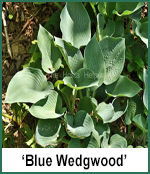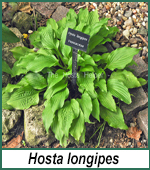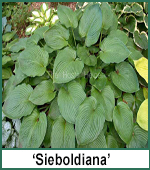|
Hosta 'Longiana Blue'
|
|
 |
|
 |
|
 |
|
 |
 Way back in the fall of 1961 Eric Smith took some pollen
from a late, re-blooming plant of
H. 'Sieboldiana'
and crossed it onto the first
flowers of an H. 'Tardiflora ’
scape. He had to finish ripening the seeds inside in a
solution of sugar and water. He was able to germinate
about 30 seeds of which 14 were blue. The result was his
famous group of “Tardianas ”,
of which ‘Halcyon’ was the first introduced from this
historic cross in 1974. He was never able to set seed on
‘Tardiflora’ again. (
The
Hosta Journal 1982 Vol. 13 No. 1 page 18.) Way back in the fall of 1961 Eric Smith took some pollen
from a late, re-blooming plant of
H. 'Sieboldiana'
and crossed it onto the first
flowers of an H. 'Tardiflora ’
scape. He had to finish ripening the seeds inside in a
solution of sugar and water. He was able to germinate
about 30 seeds of which 14 were blue. The result was his
famous group of “Tardianas ”,
of which ‘Halcyon’ was the first introduced from this
historic cross in 1974. He was never able to set seed on
‘Tardiflora’ again. (
The
Hosta Journal 1982 Vol. 13 No. 1 page 18.)
 He was able to cross this first generation (F1) with
itself and produce a second generation (F2) of very blue hostas with variable leaf shapes. ‘Blue
Wedgwood ’, ‘Blue
Dimples ’, ‘Hadspen
Blue ’ and ‘Blue
Moon ’ are some of the most widely grown.
Eric
Smith was able to achieve his goal of producing
small, heavily substanced, blue hostas for the very
small garden. He was able to cross this first generation (F1) with
itself and produce a second generation (F2) of very blue hostas with variable leaf shapes. ‘Blue
Wedgwood ’, ‘Blue
Dimples ’, ‘Hadspen
Blue ’ and ‘Blue
Moon ’ are some of the most widely grown.
Eric
Smith was able to achieve his goal of producing
small, heavily substanced, blue hostas for the very
small garden.
As a group of maybe 30 in number or more, (they have
become collector’s items now and many have been named
after the fact), “Tardianas” are all small to medium
size plants with at least some white wax so that they
appear blue in color. They have good substance and a
sort of stiffness and sturdiness to their personality.
Their clumps are usually pretty tight with dense
foliage. They are almost the perfect hostas, (you
certainly could argue that ‘Halcyon ’
is), although some of the second generation seedlings
are very slow growing, like ‘Blue
Moon ’.
 Being a student of hosta history and a great admirer of
the insight of Eric Smith, when the rare opportunity of
a re-blooming
H. 'Sieboldiana'
presented itself to me in 1997,
instead of repeating Eric Smith’s cross, I decided to
use ‘One
Man’s Treasure ’ as the second parent. ‘One Man’s
Treasure’ is a seedling of
H. longipes hypoglauca and for all intents and
purposes a form of the species, H. longipes. My new hostas were to be “Longianas”. I expected them to
be blue, larger and more vigorous than the “Tardianas”,
and well suited to all growing conditions. Being a student of hosta history and a great admirer of
the insight of Eric Smith, when the rare opportunity of
a re-blooming
H. 'Sieboldiana'
presented itself to me in 1997,
instead of repeating Eric Smith’s cross, I decided to
use ‘One
Man’s Treasure ’ as the second parent. ‘One Man’s
Treasure’ is a seedling of
H. longipes hypoglauca and for all intents and
purposes a form of the species, H. longipes. My new hostas were to be “Longianas”. I expected them to
be blue, larger and more vigorous than the “Tardianas”,
and well suited to all growing conditions.
 I recovered 15 seeds from that cross and five seedlings
made it to maturity. There was not a ‘Halcyon’ in that
group, all were mediocre plants brimming with genetic
potential. In 2001, hundreds of second generation seeds
were taken from the F1 seedlings and germinated. Several
hundred seedlings were then culled, first for the best
blue color, and second for interesting leaf shapes, and
soon there were only 25. I recovered 15 seeds from that cross and five seedlings
made it to maturity. There was not a ‘Halcyon’ in that
group, all were mediocre plants brimming with genetic
potential. In 2001, hundreds of second generation seeds
were taken from the F1 seedlings and germinated. Several
hundred seedlings were then culled, first for the best
blue color, and second for interesting leaf shapes, and
soon there were only 25.
In 2010, 13 years later, I am introducing four of my
second generation “Longiana” seedlings. They are a very
special group of hostas, a new genetic combination, not
of the historic proportions of the “Tardianas” by far,
but a new line of breeding for all hosta hybridizers to
incorporate into their seedling programs. All four are
vigorous growing medium to large hostas with good color
and distinct leaf shapes. They have good substance but
lack the stiffness of the “Tardianas” and are more
interesting to the eye. While none may ever rival ‘Halcyon
’, they are great hostas.
|
 |
 |
 |
 |
 |
|

 |
|
|
|
|



